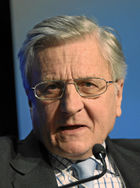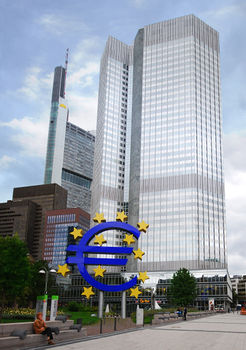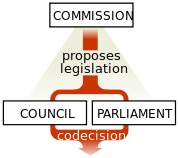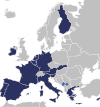European Central Bank
 European Central Bank
|
|||||||||||||||||||||||||||||||||||||||||||||
|
|||||||||||||||||||||||||||||||||||||||||||||
| Headquarters | Frankfurt, Germany | ||||||||||||||||||||||||||||||||||||||||||||
|---|---|---|---|---|---|---|---|---|---|---|---|---|---|---|---|---|---|---|---|---|---|---|---|---|---|---|---|---|---|---|---|---|---|---|---|---|---|---|---|---|---|---|---|---|---|
| Established | 1 June 1998 | ||||||||||||||||||||||||||||||||||||||||||||
| President | Jean-Claude Trichet | ||||||||||||||||||||||||||||||||||||||||||||
| Central bank of | |||||||||||||||||||||||||||||||||||||||||||||
| Currency | Euro | ||||||||||||||||||||||||||||||||||||||||||||
| ISO 4217 Code | EUR | ||||||||||||||||||||||||||||||||||||||||||||
| Reserves |
€526bn in total
|
||||||||||||||||||||||||||||||||||||||||||||
| Base borrowing rate | 1.00% | ||||||||||||||||||||||||||||||||||||||||||||
| Base deposit rate | 0.25% | ||||||||||||||||||||||||||||||||||||||||||||
| Website | ecb.europa.eu | ||||||||||||||||||||||||||||||||||||||||||||
| Preceded by |
16 national banks
Banca d'Italia
Banco de España Banco de Portugal Τράπεζα της Ελλάδος (Bank of Greece) Banka Slovenije Banque Centrale du Luxembourg Central Bank of Cyprus Banque de France Central Bank and Financial Services Authority of Ireland Bank Ċentrali ta’ Malta De Nederlandsche Bank Deutsche Bundesbank Nationale Bank van België / Banque nationale de Belgique Národná banka Slovenska Österreichische Nationalbank Suomen Pankki |
||||||||||||||||||||||||||||||||||||||||||||
The European Central Bank (ECB) is the institution of the European Union (EU) tasked with administrating the monetary policy of the 16 EU member states taking part in the Eurozone. It is thus one of the world's most important central banks. The bank was established by the Treaty of Amsterdam in 1998, and is headquartered in Frankfurt, Germany. The current President of the ECB is Jean-Claude Trichet.
Contents |
History
The European Central Bank is the de facto successor of the European Monetary Institute (EMI). The EMI was established at the start of the second stage of the EU's Economic and Monetary Union (EMU) to handle the transitional issues of states adopting the euro and prepare for the creation of the ECB and European System of Central Banks (ESCB). The EMI itself took over from the earlier European Monetary Co-operation Fund (EMCF).[1]

The ECB formally replaced the EMI on 1 June 1998 by virtue of the Treaty on European Union (TEU, Treaty of Maastricht), however it did not exercise its full powers until the introduction of the euro on 1 January 1999, signalling the third stage of EMU. The bank was the final institution needed for EMU, as outlined by the EMU reports of Pierre Werner and President Jacques Delors.[1] It was established on 1 June 1998.[2]
The first President of the Bank was Wim Duisenberg, the former president of the Dutch central bank and the European Monetary Institute. While Duisenberg had been the head of the EMI (taking over from Alexandre Lamfalussy of Belgium) just before the ECB came into existence, the French government wanted Jean-Claude Trichet, former head of French central bank, to be the ECB's first president. The French argued that since the ECB was to be located in Germany, its President should be French. This was opposed by the German, Dutch and Belgian governments who saw Duisenberg as a guarantor of a strong euro.[3] Tensions were abated by a gentleman's agreement in which Duisenberg would stand down before the end of his mandate, to be replaced by Trichet, an event which occurred in November 2003.
There had also been tension over the ECB's Executive Board, with the United Kingdom demanding a seat even though it had not joined the Single Currency.[3] Under pressure from France three seats were assigned to the largest members, France, Germany, Italy and Spain. Despite such a system of appointment the board asserted its independence early on in resisting calls for interest rates and future candidates to it.[3]
When the ECB was created, it covered a Eurozone of eleven members. Since then, Greece joined in January 2001, Slovenia in January 2007, Cyprus and Malta in January 2008, and Slovakia in January 2009, enlarging the bank's scope and the membership of its Governing Council.[1]
On December 1, 2009 Treaty of Lisbon entered into force, ECB according to the article 13 of TFEU, gained official status of an EU institution.
Powers and objectives
The primary objective of the ECB is to maintain price stability within the Eurozone, or in other words to keep inflation low. The Governing Council defined price stability as inflation (Harmonised Index of Consumer Prices) of below, but close to, 2%.[4]. Unlike for example the United States Federal Reserve Bank, the ECB has only one primary objective with other objectives subordinate to it.
The key tasks of the ECB are to define and implement the monetary policy for the Eurozone, to conduct foreign exchange operations, to take care of the foreign reserves of the European System of Central Banks and promote smooth operation of the financial market infrastructure under the Target payments system[5] and being currently developed technical platform for settlement of securities in Europe (TARGET2 Securities). Furthermore, it has the exclusive right to authorise the issuance of euro banknotes. Member states can issue euro coins but the amount must be authorised by the ECB beforehand (upon the introduction of the euro, the ECB also had exclusive right to issue coins[5]).
The bank must also co-operate within the EU and internationally with third bodies and entities. Finally it contributes to maintaining a stable financial system and monitoring the banking sector.[6] The latter can be seen, for example, in the bank's intervention during the 2007 credit crisis when it loaned billions of euros to banks to stabilise the financial system.[7] In December 2007 the ECB decided in conjunction with the Federal Reserve under a program called Term auction facility to improve dollar liquidity in the eurozone and to stabilise the money market.[8]
Organisation
| European Union |
 This article is part of the series: |
|
Policies and issues
|
|
Foreign relations
|
The Executive Board is responsible for the implementation of monetary policy defined by the Governing Council and the day-to-day running of the bank. In this it can issue decisions to national central banks and may also exercise powers delegated to it by the Governing Council. It is composed of the President of the Bank (currently Jean-Claude Trichet), a vice president and four other members. They are all appointed by common accord of the eurozone member states for non-renewable terms of eight years.

The General Council is a body dealing with transitional issues of euro adoption, for example fixing the exchange rates of currencies being replaced by the euro (continuing the tasks of the former EMI). It will continue to exist until all EU Member States adopt the euro, at which point it will be dissolved. It is composed of the President and Vice President together with the governors of all of the EU's national central banks.[9][10]
Independence and future
Furthermore, not only must the bank not seek influence, but EU institutions and national governments are bound by the treaties to respect the ECB's independence. For example, the minimum term of office for an national central bank governor is five years and members of the executive board have a non-renewable eight-year term.[11] To offer some accountability, the ECB is bound to publish reports on its activities and has to address its annual report to the European Parliament, the European Commission, the Council of the European Union and the European Council.[12] The European Parliament also gets to question and then issue its opinion on candidates to the executive board.[13]
The bank's independence has notably come under intense criticism since the election of Nicolas Sarkozy as French President. Sarkozy has sought to make the ECB more susceptible to political influence, to extend its mandate to focus on growth and job creation, and has frequently criticised the bank's policies on interest rates.
Location

The bank is based in Frankfurt, the largest financial centre in the Eurozone. Its location in the city is fixed by the Amsterdam Treaty along with other major institutions.[14] In the city, the bank currently occupies Frankfurt's Eurotower until its purpose-built headquarters are built.[15]
In 1999 an international architectural competition was launched by the bank to design a new building. It was won by a Vienna-based architectural office named Coop Himmelbau. The building will be approximately 180 metres (591 ft) tall (the present building is 148 m/486 ft) and will be accompanied with other secondary buildings on a landscaped site on the site of the former wholesale market (Großmarkthalle) in the eastern part of Frankfurt am Main. The main construction work will commence in October 2008, with completion scheduled during 2014.[16][17] It is expected that the building will become an architectural symbol for Europe and is designed to cope with double the number of staff who operate in the Eurotower.[15]
See also
|
||||||||||||||||||||||||||||||||||||||||||||||||||||
References
- ↑ 1.0 1.1 1.2 "European Central Bank". European NAvigator. http://www.ena.lu?lang=2&doc=8034. Retrieved 15 October 2007.
- ↑ ECB: Economic and Monetary Union
- ↑ 3.0 3.1 3.2 "The third stage of Economic and Monetary Union". European NAvigator. http://www.ena.lu?lang=2&doc=14950. Retrieved 16 October 2007.
- ↑ "Powers and responsibilities of the European Central Bank". European Central Bank. http://www.ecb.int/ecb/orga/tasks/html/index.en.html. Retrieved 10 March 2009.
- ↑ 5.0 5.1 Fairlamb, David; Rossant, John (12 February 2003). "The powers of the European Central Bank". BBC News. http://news.bbc.co.uk/1/hi/business/business_basics/86006.stm. Retrieved 16 October 2007.
- ↑ "The European Central Bank (ECB)". Europa (web portal). http://europa.eu/scadplus/leg/en/lvb/o10001.htm. Retrieved 16 October 2007.
- ↑ Lander, Mark (14 August 2007). "Credit Squeeze Puts Europe's Bank in Spotlight". New York Times. http://www.nytimes.com/2007/08/14/business/worldbusiness/14euro.html?_r=1&n=Top/Reference/Times%20Topics/Organizations/E/European%20Central%20Bank&oref=slogin. Retrieved 16 October 2007.
- ↑ "ECB press release on dollar liquidity". ECB. http://www.ecb.int/press/pr/date/2008/html/pr080110_2.en.html.
- ↑ "Composition of the European Central Bank". European NAvigator. http://www.ena.lu?lang=2&doc=8035. Retrieved 15 October 2007.
- ↑ "The General Council". European Central Bank. http://www.ecb.europa.int/ecb/orga/decisions/genc/html/index.en.html. Retrieved 15 October 2007.
- ↑ "Independence". European Central Bank. http://www.ecb.int/ecb/orga/independence/html/index.en.html. Retrieved 15 October 2007.
- ↑ "Accountability". European Central Bank. http://www.ecb.int/ecb/orga/accountability/html/index.en.html. Retrieved 15 October 2007.
- ↑ "Executive Board" (PDF). Banque de France. 2005. http://www.banque-france.fr/gb/eurosys/telechar/europe/Directoire_GB.pdf. Retrieved 15 October 2007.
- ↑ "Consolidated versions of the treaty on European Union and of the treaty establishing the European Community" (PDF). Eur-lex. http://eur-lex.europa.eu/LexUriServ/site/en/oj/2006/ce321/ce32120061229en00010331.pdf. Retrieved 12 June 2007.
- ↑ 15.0 15.1 Dougherty, Carter. "In ECB future, a new home to reflect all of Europe". International Herald Tribune. http://www.iht.com/articles/2004/11/16/ecb_ed3_.php. Retrieved 2 August 2007.
- ↑ "Winning design by Coop Himmelb(l)au for the ECB's new headquarters in Frankfurt/Main". European Central Bank. http://www.ecb.int/ecb/premises/html/image29.en.html. Retrieved 2 August 2007.
- ↑ "Launch of a public tender for a general contractor to construct the new ECB premises". European Central Bank. http://www.ecb.int/press/pr/date/2007/html/pr070710_3.en.html. Retrieved 2 August 2007.
External links
- European Central Bank, official website.
- New ECB Premises, official website.
- The European Central Bank, European NAvigator.
- European Central Bank: history, role and functions, ECB website.
- Infocheese: ECB
- forex-history.net, historical currency charts based on the data published daily by the ECB.
- ECB Intelligent guess, Historical bank rate (since 2000) based on the data published by the ECB.
- World Interest Rates, Europe Interest Rates data and chart, updated by ForexMotion.com.
|
|||||||||||||||||||||||||||||||||||||||||||||||||||||||||||||||||||||||||||||||||||||||||||||||||||||||||||||||||||||






